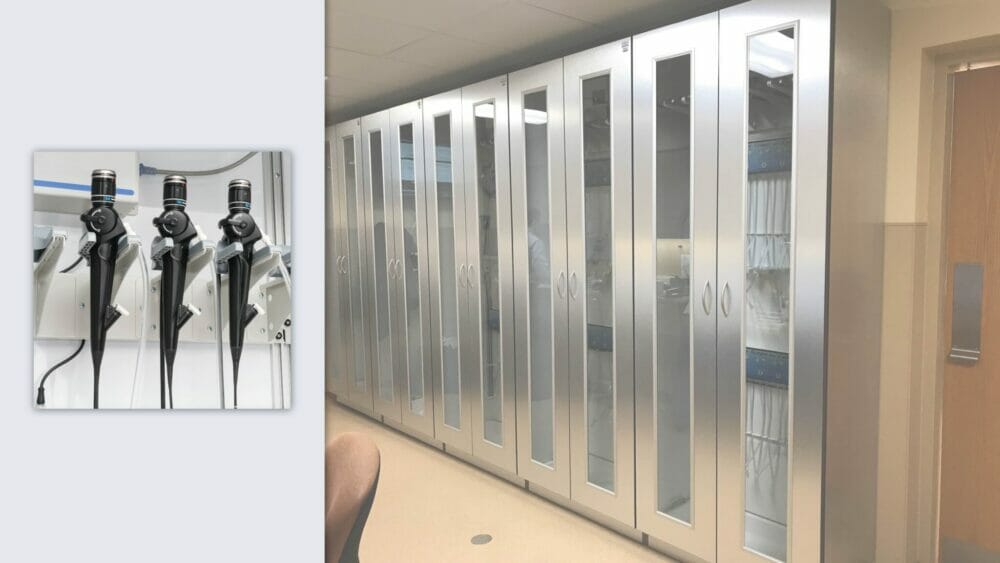
Infections due to endoscopy procedures remain a concern, according to a Johns Hopkins University study published in Gut. While infection rates vary by facility and procedure type, the Centers for Disease Control and Prevention (CDC) and the U.S. Food and Drug Administration (FDA) point to medical device reprocessing as a known source of multidrug-resistant endoscopy-associated infections.
The Healthcare Infection Control Practices Advisory Committee has worked to develop endoscope reprocessing guidance to reduce the risk of infectious disease spread, yet has not decided on a safe endoscope hang time requirement.
What is “hang time”?
Endoscope hang time refers to the amount of time a reprocessed scope can be stored before needing to be reprocessed again. In other words, hang time is the shelf life of a reprocessed endoscope.
How long a scope is stored between patients is important because:
- Reprocessed endoscopes are hard to clean and are at risk of retained patient fluid or tissue within its tiny lumens. A moist environment can foster the growth of pathogens, potentially putting the next patient at risk of infection.
- Endoscopes are semi-critical medical devices and must be stored aseptically. As time passes, devices may be exposed to dust, airborne microbes, or pathogens from being handled.
Is there an industry standard for endoscope hang time?
No, not at this time. Regulatory agencies have weighed in on how long endoscopes can be safely stored but there is no industry consensus. Research conducted on safe hang times has yielded results that range from seven days to twelve weeks.
Many variables impact the result of reprocessing, such as water temperature and quality, technician training, type of scope, and time between the initial cleaning and disinfection.
What do industry experts say?
The Association for the Advancement of Medical Instrumentation (AAMI) suggests that, based on the lack of clear evidence and without consensus, facilities develop their endoscope hang time policies based on industry regulatory guidance and current studies. Facilities should first conduct a risk assessment to determine how long their endoscopes can hang before reprocessing. The CDC agrees.
The Society of Gastroenterology Nurses and Associates (SGNA) recommends storing endoscopes for no longer than seven days as long as the scopes are processed according to the manufacturer’s instructions for use (IFUs) and best practice industry guidance.
The SGNA guidance is supported by a study published by the World Journal of Gastrointestinal Endoscopy. This study showed that the bacterial load on various endoscopes did not vary when tested on days one and seven. The researchers concluded that endoscopes could be stored hanging for up to seven days without compromising patient safety.
A multi-society task force reviewed multiple studies and concluded that although storing endoscopes for more than seven days may not result in higher bacterial infection rates, the research remains unclear on exactly how long endoscopes can be safely stored.
What is a risk assessment?
Conducting a hang time risk assessment involves a thorough review of the reprocessing steps. Because industry leaders and regulatory agencies have not decided how long endoscopes can hang before being reprocessed, the information gathered from a risk assessment can help the facility to develop a hang time policy.
The facility should also review the literature to ensure that current studies and industry guidance supports the proposed hang time requirement.
A risk assessment starts with knowing your scope and its manufacturer’s IFUs. Questions to consider during a risk assessment may include:
- What type of scope is it?
- Does the scope have a lumen?
- Was the endoscope reprocessed according to the manufacturer’s IFUs and industry guidelines?
- Was the scope handled and transported aseptically throughout reprocessing?
- What was the quality of the water during the final rinse?
- Was the scope dried thoroughly before storage?
- Has the scope been stored to minimize the introduction of pathogens during storage?
Best practice tips for storing endoscopes
The SGNA bases its endoscope storage recommendations on research that indicates that scopes should be stored:
- Only after verifying that the scope is clean and dry
- In a clean environment that has good ventilation and is free of dust
- Free hanging so they do not have contact with the bottom of the cabinet or other scopes
There are two styles of scope cabinets:
- Conventional cabinets, like InnerSpace’s Evolve Specialty Scope cabinets
- Scopes must hang vertically
- May circulate medical-grade or HEPA-filtered air throughout the cabinet
- Drying cabinets, like InnerSpace’s Scope Drying and Tracking cabinet
- Scopes may be stored vertically or horizontally, depending on the configuration of the cabinet
- Includes connectors that circulate HEPA-filtered air throughout the channels of each stored scope
- Circulates pressurized medical-grade air throughout the cabinet
Choose cabinets that are easy to clean with recommended disinfectants.
Ensure that scopes do not touch the bottom of the cabinet or other scopes to prevent the transfer of microorganisms.
Clear doors can help prevent staff from opening and closing the cabinet unnecessarily.
Use clean gloves when touching clean scopes.
Have a way to track each scope from patient use to reprocessing, such as through InnerSpace’s Cloud endoscopy data services.
Endoscope reprocessing requirements continue to be a hot topic in healthcare. Use of high quality storage cabinets that dry and track your scopes according to your facility’s standards can give you, and your patients, peace of mind.

Cindy Blye
Content WriterCindy Blye, BSN, RN, CCM is a Registered Nurse and Certified Case Manager. She is an Alumni of West Virginia University School of Nursing (BSN), and a member of the Association of Health Care Journalists and The Authors Guild.
